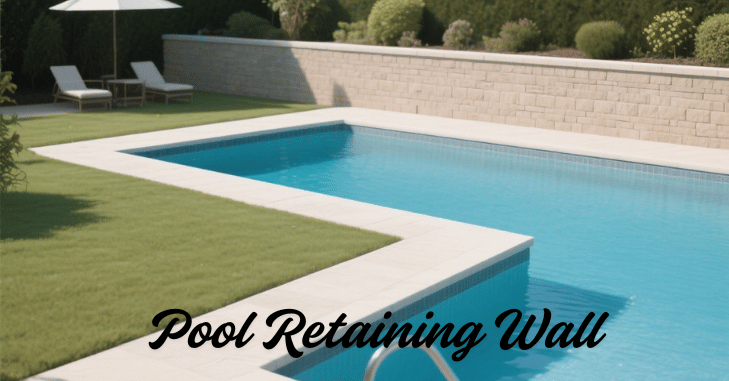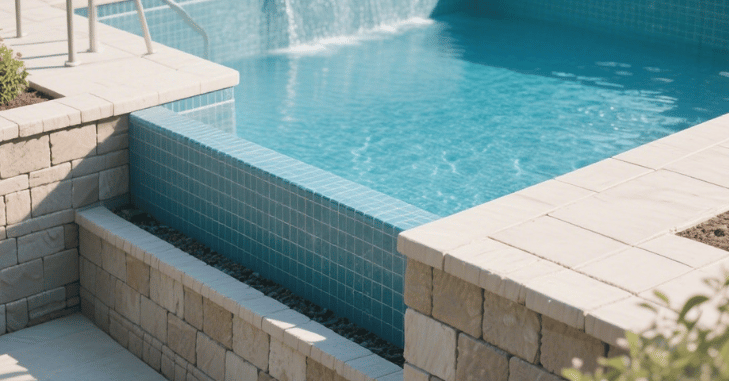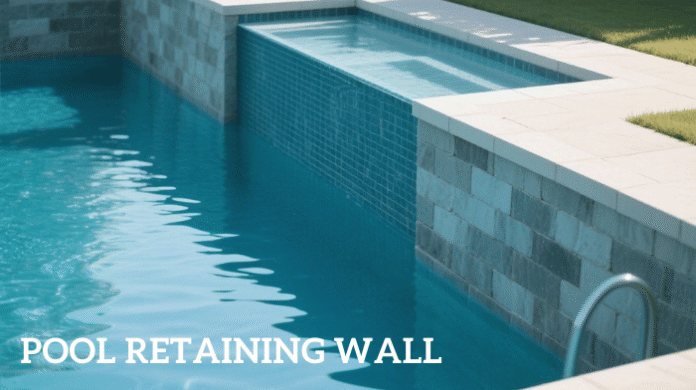Table of Contents
Introduction
A backyard swimming pool is often the centerpiece of outdoor living, offering relaxation, entertainment, and a beautiful aesthetic. However, installing and maintaining a pool in areas with uneven terrain or natural slopes can present significant challenges. This is where pool retaining walls become indispensable.
These engineered structures not only stabilize the soil and prevent erosion but also provide a visually appealing framework that enhances the overall landscape design. Whether you’re dealing with a hillside, elevated yard, or simply want to create defined zones around your pool, understanding what pool retaining walls are and how they function is crucial for a safe, durable, and attractive pool environment.
Whether you want to create a seamless transition between different levels of your yard, add seating or water features, or simply protect your pool’s foundation, a thoughtfully planned pool retaining wall can be a game-changer in your outdoor living experience.
| Aspect | Key Points |
| Pool Retaining Wall | Stabilize soil, prevent erosion, support pool foundation, and define yard zones |
| Types | Gravity, Reinforced, Segmental, Cantilevered |
| Materials | Concrete, Natural Stone, Concrete Blocks, Brick, Timber |
| Design Ideas | Water features, built-in seating, LED lighting, multi-tiered planters, privacy screens |
| Installation Considerations | Proper drainage, local codes, engineering for tall walls, integration with pool deck |
| Costs (per linear foot) | Concrete Block: $20–$35, Poured Concrete: $30–$60, Natural Stone: $50–$100+, Brick: $40–$75, Timber: $15–$30 |
| Maintenance Tips | Inspect for cracks, ensure drainage, clean surfaces, and manage nearby vegetation roots |
What Is a Pool Retaining Wall?
A pool retaining wall is a specially designed structure built to hold back soil and create a stable, level area around a swimming pool. These walls are essential in landscapes where there is a natural slope or uneven terrain, as they prevent soil erosion and shifting that could compromise the pool’s foundation and surrounding area.
Constructed from durable materials such as concrete, stone, brick, or segmental blocks, pool retaining walls serve both functional and aesthetic purposes. Functionally, they provide critical support to hold back the earth and manage water drainage, protecting the pool structure from damage caused by soil movement or water buildup.
Aesthetically, these walls can be designed to complement the pool’s style, integrating features like planters, seating, or lighting to enhance the overall outdoor living space. Whether used to level a hillside for an in-ground pool, reinforce the edge of an infinity pool, or define distinct zones in a backyard, pool retaining walls play a crucial role in ensuring the safety, longevity, and visual appeal of a pool area.

Why You Might Need a Pool Retaining Wall?
| Purpose | Description |
| Slope Management | Level out inclined ground to securely install a pool in sloped yards. |
| Erosion Control | Prevents soil from washing into the pool during heavy rains, especially on elevated sites. |
| Structural Support | Reinforces above-ground or infinity pools, especially where land drops off. |
| Design and Zoning | Defines pool boundaries, separates the pool from the lawn or garden, and creates multi-level entertainment areas. |
Types of Pool Retaining Walls
Gravity Walls
These are thick and heavy, relying on their weight to resist pressure. Ideal for low-height applications. They require a solid base and are often made from stone, concrete, or brick. Gravity walls are low-maintenance and blend well with natural surroundings.
Reinforced Retaining Walls
Built with steel reinforcement and often used with concrete blocks or poured concrete. Suitable for high walls and sloped sites. They offer superior strength and durability, making them perfect for holding back large amounts of soil. Proper drainage is essential to maintain their stability over time.
Segmental Retaining Walls
Made from interlocking blocks without mortar. They’re flexible and easier to install than poured concrete. These walls allow slight movement, which helps prevent cracking. They’re a popular choice for DIY landscaping due to their ease of assembly.
Cantilevered Retaining Walls
Constructed with reinforced concrete and supported by a slab that extends beneath the retained soil. Ideal for taller applications. Their T-shaped base provides strong leverage against soil pressure. Though costlier, they are efficient for large-scale or commercial-grade projects.
Best Materials for Pool Retaining Walls
Choosing the right material balances function, durability, and aesthetics. Common options include
| Material | Pros | Cons |
| Concrete | Durable, strong, customizable | Requires skilled labor, costlier |
| Natural Stone | Elegant, blends with nature | Expensive, heavy |
| Concrete Blocks | Affordable, versatile | May not suit all luxury designs |
| Brick | Classic look, durable | Labor-intensive, prone to shifting |
| Timber | Budget-friendly, rustic charm | Shorter lifespan, prone to rot |
Design Ideas for Pool Retaining Walls
Enhancing pool retaining walls with functional and aesthetic features can significantly elevate your outdoor space. One popular option is integrating water features like waterfalls or sheer descents directly into the wall, creating a luxurious and tranquil ambiance.
Built-in seating, such as benches or ledges, can also be incorporated into the design, offering convenient social zones without taking up valuable pool deck space. For added ambiance and safety during evening hours, LED lighting can be embedded within the wall, casting a warm glow and highlighting architectural details.
Multi-tiered retaining walls with planters are another creative option, allowing you to introduce greenery and soften the appearance of stone or concrete with natural textures and vibrant color. Finally, higher retaining walls fitted with trellises or privacy screens can create secluded lounging areas, perfect for relaxation and enhanced privacy in your backyard oasis.

Installation Considerations
- Drainage is Key: Poor drainage behind a retaining wall can lead to failure. Install weep holes, gravel backfill, or drainage pipes.
- Local Codes: Always check zoning laws or HOA requirements regarding wall height and proximity to property lines.
- Engineering Requirements: For walls over 3–4 feet, professional engineering is often required to ensure safety and compliance.
- Integration with Pool Deck: Ensure the wall seamlessly integrates with decking, coping, and landscaping to avoid uneven transitions.
Costs of Pool Retaining Walls
| Material | Cost per Linear Foot (Installed) |
| Concrete Block | $20–$35 |
| Poured Concrete | $30–$60 |
| Natural Stone | $50–$100+ |
| Brick | $40–$75 |
| Timber | $15–$30 |
Maintenance Tips
While retaining walls are built to last, regular upkeep is essential to ensure their longevity. Start by inspecting the wall periodically for cracks or signs of structural issues, especially after heavy rainfall, as these can indicate underlying problems.
It’s also important to check the drainage system, make sure weep holes are clear, and prevent water from pooling behind the wall, which could lead to pressure buildup and eventual failure.
Keeping the wall clean is another key maintenance task; pressure washing stone or concrete surfaces helps prevent mold growth and reduce staining. Lastly, manage nearby vegetation carefully by avoiding planting trees with aggressive root systems too close to the wall, as these roots can interfere with the wall’s stability over time.

Conclusion
In summary, pool retaining walls are much more than mere structural supports—they are integral components of a well-designed pool landscape that enhance both safety and aesthetics. By stabilizing soil, preventing erosion, and allowing creative landscaping solutions, these walls help transform challenging terrains into stunning outdoor retreats.
Choosing the right type of retaining wall, material, and design based on your specific needs ensures long-lasting durability and functionality. Additionally, paying attention to proper installation, drainage, and maintenance will protect your investment and keep your pool area looking beautiful for years to come.
Want to know about ‘How To Make Your Pool As Safe As Possible‘ Check out our ‘Home Improvement‘ category.
FAQs
Keeping dirt and debris from washing down the slope and into your pool or onto the deck or patio is the goal of a pool retaining wall.
The purpose of a retaining wall is to secure a mound of earth or something similar, such as the edge of an excavation or terrace.
The most popular wall systems are made of steel and polymer (plastic). Although it is rarely done now, some pool contractors used to construct concrete block walls for vinyl pools.
A building must be anchored to the ground to have enough structural stability.



























